Fire and Ice Photo Tour 2010 – John Knight
Below are John Knight’s images from the 2010 Fire and Ice tour. Be sure to drop by John’s website for lots more inspiration!
- ©John Knight
Chephren’s Mirror-Mount Chephren and Waterfowl Lake, Banff NP, Alberta
Canon EOS 5D Mark2, Canon TS-E24mm f/3.5L II
Exposure: 1/5 sec @ f/8.0, ISO 100
Filters: Circular polarizer (Singh-Ray) + 2-stop grad (Singh-Ray)
Tripod & Head: Gitzo 3540 XLS with RRS BH-55 ballhead & cable release
Description: Sunrise at Waterfowl Lake along the Icefield Parkway was our first stop on the 2010 ‘Fire and Ice Tour’. This image was one of my first using a tilt-shift lens. For this shot, I looked for something ‘simple’, i.e., just the mountain and its reflection. With my camera in Av mode, I used the camera’s ‘live view’ and the lens’ ‘tilt’ capability (i.e., with a ‘tilt’ of only a couple of ticks with the tripod at eye level) on the lens to make sure that everything was in focus from a third of the way into the image to the mountain top. Before taking the shot, I adjusted the polarizing filter and inserted a 2-stop grad filter.

©John Knight
Fire on Ice, Preacher’s Point, Abraham Lake, Alberta
Canon EOS 5D Mark2, Canon TS-E24mm f/3.5L II
Exposure: 1/5 sec @ f/8.0, ISO 100
Filters: Circular polarizer (Singh-Ray) + 2-stop grad (Singh-Ray)
Tripod & Head: Gitzo 3540 XLS with RRS BH-55 ballhead & cable release
Description: For this shot, I was poised precariously near the shoreline on the thin newly formed ice of Abraham Lake. I made sure that I stayed close to the shoreline where the water was shallow. The main challenge, however, was to stay in one place while lying on the polished ice. Each time that I moved, gravity tried to pull me down slope towards deeper water. Walking crampons would have been great, but they were in the car. A polarizing and a 2-stop grad filter were used with a low ISO to slow the shutter speed so that I could capture some of the time-lapsed colour changes in the clouds. I took some shots with a 5-stop ND filter (Singh-Ray) to further slow the shutter speed (next image), but the colour caste from this filter (magenta) created a very different look to the sunrise. I preferred the shot here without the 5-stop ND filter.
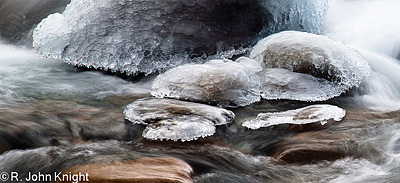
©John Knight
Icy Stepping-stones, Mistaya River Canyon, Banff NP, Alberta
Canon EOS 5D Mark2, Canon EF24-105 f/4.0L IS USM @ 97mm focal length
Exposure: 0.3 sec @ f/16.0, ISO 100
Filters: Circular polarizer (Rodenstock) + 2-stop grad (Singh-Ray) + 5-stop neutral density filter (Lee)
Tripod & Head: Gitzo 3540 XLS with RRS BH-55 ballhead & cable release
Description: This image was selected from within a larger image. I wanted to capture the detail of the crystalline and amorphous ice types framed by the moving water. The smaller ice-covered rocks look like stepping stones, drawing your focus into the image and towards the large boulder in the background.
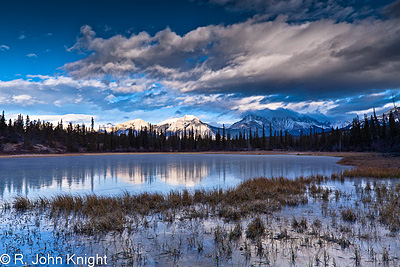
©John Knight
Autumn’s Tranquil Transition, Whirlpool Point, Kootenay Plains, Alberta
Canon EOS 5D Mark2, Canon TS-E24mm f/3.5L II
Exposure: 1/4 sec @ f/16.0, ISO 100
Filters: Circular polarizer (Singh-Ray) + 2-stop grad (Singh-Ray)
Tripod & Head: Gitzo 3540 XLS with RRS BH-55 ballhead & cable release
Description: Near the end of our tour and just before sunset, we stopped at Whirlpool Point along the David Thompson Highway. I scrambled down to a small protected lake that had frozen recently. The gathering storm clouds framed the highlighted mountains in the middle ground. The bluish-grey light from the setting sun helped to create a moody feeling. The protected tranquility of this scene was an illusion of reality. Only a short distance away, frigid and dust-laden winds howled down the North Saskatchewan River valley, a stark reminder that winter was just around the corner.
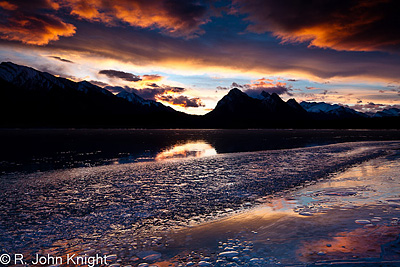
©John Knight
Frozen Orbs, Preacher’s Point, Abraham Lake, Alberta
Canon EOS 5D Mark2, Canon TS-E24mm f/3.5L II
Exposure: 30 sec @ f/13.0, ISO 100
Filters: Circular polarizer (Singh-Ray) + 2-stop grad (Singh-Ray) + 5-stop neutral density (Singh-Ray)
Tripod & Head: Gitzo 3540 XLS with RRS BH-55 ballhead & cable release
Description: This shot was taken with a 5-stop ND filter (Singh-Ray). The magenta colour caste created by this filter was then adjusted in Photoshop by using the ‘white point eye-dropper’ tool to sample different parts of the image until a pleasing result was found. The orbs in the foreground were formed from bubbles of methane gas that seeped from the lake bottom and were trapped in the ice as the lake froze.
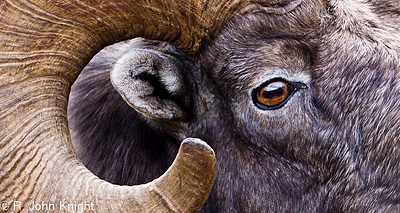
©John Knight
Bighorn Audio-visual, Bighorn Sheep, Jasper NP, Alberta
Canon EOS 1D Mark IV, Canon EF500mm f/4.0L IS USM
Exposure: 1/250 sec @ f/4.5, ISO 800
Filters: none
Support: bean-bag
Description: Even during a tour focused primarily on landscape photography, it is important to keep a camera and longer lens handy for surprise encounters with wildlife. While returning to Jasper from Moberly Flats we found a herd of Big Horn sheep. With my other camera, I quickly captured several head-shots before everyone started to leave. In keeping with the principles of ‘first-best-different’ (Bill Marsh), I decided, in collaboration with my son, Eric, to create an unusual image of the sheep’s head that is ‘different’. The result focuses your attention around curved geometry of the horn and from the ear towards the sheep’s eye.
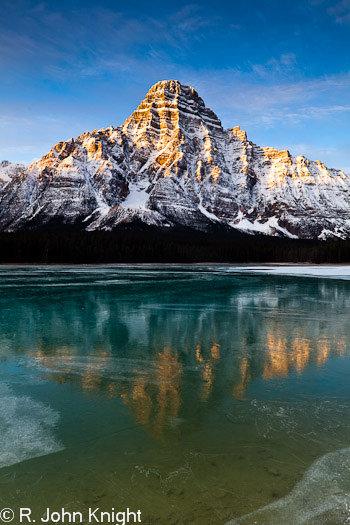
December 4, 2010 at 10:14 AM
That bighorn shot is awesome. I love the detail. Very interesting composition!
December 4, 2010 at 10:47 AM
These are lovely images John and i really enjoyed reading the detailed explanations. I LOVE that last image of the big horn sheep – wicked cool composition on that one. A real pleasure hanging out with you on the tour and I’ve already gone through many images on your site – beautiful imagery!
December 4, 2010 at 11:59 AM
I really like the big horn sheep photo !
December 4, 2010 at 1:41 PM
Hello John,
Great selection! I too like that different ram shot and I am quite amazed how this turned out, considering the low light, distance, focal length and lack of support. And thanks again for all the driving.
December 4, 2010 at 2:11 PM
Wow! Gorgeous collection! Love your description, very interesting.
December 4, 2010 at 2:50 PM
A super set John. I like the indepth descriptions for each image. A very different & imaginative portrait of the Bighorne sheep, I like it.
December 5, 2010 at 6:38 AM
John, you certainly make very good use of that new til/shift lens. My favorites are 2 (beautiful ice bubbles there) and 6, which seems to be everyone’s favorite. Even more amazing to me is how this turned out as Alan already noted, that 500mm lens is not exactly the prototype of hand-holdable lenses. Great job!
December 5, 2010 at 9:34 AM
Really great John! I love the 2 images from Preacher’s Point- I loved the way that sunrise started out with that one long pink cloud and the reflections on the ice in the second pic are totally sweet. I’llecho what the others said about the bighorn shot- totally killer!
December 5, 2010 at 10:08 AM
Great job John. Like most the comments, I really like the big horn image. The shapes and textures are fascinating. It’s definitely a different image and I find it captivating.
December 5, 2010 at 9:06 PM
Thank you everyone for your comments. I’ll really enjoyed meeting everyone on the 2010 Fire & Ice Tour with Darwin and Alan. It was a memorable experience. Crawling around on the ice with my camera and tripod was something that I’ve never done before. I will look forward to doing again in the future, perhaps with some of you. Seeing everyone’s images on Darwin’s Blog is a real learning experience. We all went to the same places, and yet many different perspectives and images emerged from everyone’s cameras. I find myself looking at your images, and seeing different ways and things to see. Than you everyone!